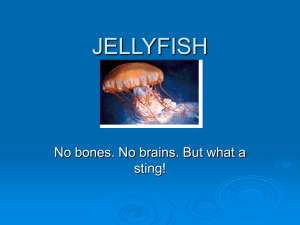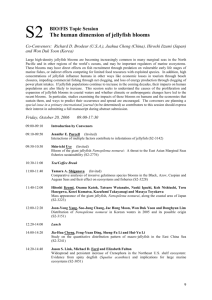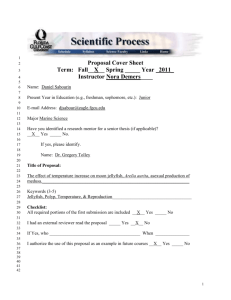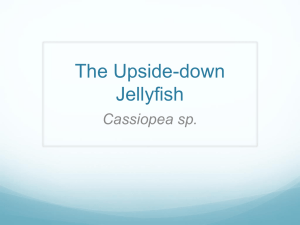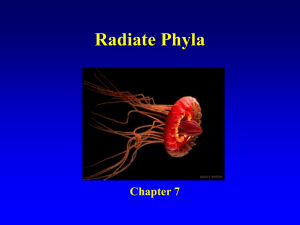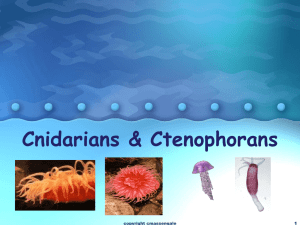Jon M. Gebhardt
advertisement
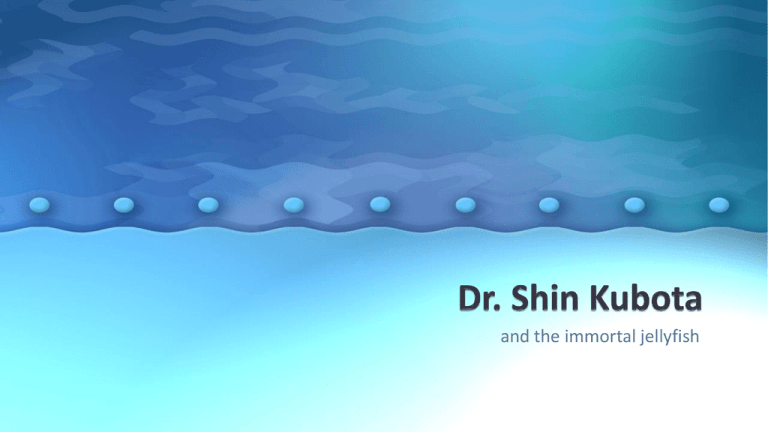
and the immortal jellyfish Who is Dr. Shin Kubota? Professor of marine biology at Kyoto University. Born and still has a home in Shirahama Japan. Author of 12 books on various subjects (4 of which are on jellyfish). Self described “avid jellyfish karaoke singer”, and owner of an outstanding jellyfish hat. His webpage listing his books and latest research (although his English isn’t the best) http://www.seto.kais.kyotou.ac.jp/shinkubo/shinkubo_ho me/index_en.html Scarlett Jellyfish (Turritopsis dohrnii) Approximately 3-4mm in diameter. Young specimens 1 mm in diameter have only eight tentacles evenly spaced out along the edge, while adult specimens have 80-90 tentacles. Thought to have originated in the Caribbean they now span all over the world. Can regenerate itself back through its entire life cycle in about two months. 100% of specimens have successfully regenerated in a controlled environment. The Hundred Year Study Kubota’s “teacher’s teacher” as he worded it began researching these jellyfish with no idea of its regenerative properties. Kubota’s teacher focused the study more in 1971 looking to decipher why the population was experiencing rapid growth. Shin Kubota himself has been studying the Scarlet Jellyfish since 1976. He noted during an interview however that the Scarlet Jellyfish had actually hidden this ability since the late 1800s when Showa Emperor Hirohito began a study on local jellyfish. How This Discovery Was Made? "One day in my plankton net, there was a small scarlet jellyfish from the south, which had many sharp sticks stuck into its body, I thought 'poor thing' and removed all of the sticks, hoping it may become better and swim again. But it didn't and shrunk. However, it rejuvenated!“ - Dr. Shin Kubota. Miracle? A wounded or diseased medusa Scarlett Jellyfish can revert itself back into a polyp and restart its own life cycle. It does this by: First going into a “meatball” type form in which a Scarlet Jellyfish degenerates and sheds all of its tentacles leaving just the bell. Second it gently sinks down to the ocean floor where it will develop a stolon and root itself. Soon after it develops into a hydroid (polyp form) so it can extract nutrients as it regenerates. Third it begins to regenerate itself inside of the polyp. Cells from both the circulatory and bell surface have to be present for the regeneration to take place. This is because it clones its damaged cells and needs some of each to complete its cellular differentiation. Finally the hydroid sprout branches one of which will develop a medusa bud, when it blooms the jellyfish reemerges in its infant state. This process takes approximately three days total, however it takes about 2 months to reach maturity again. Moses Znaimer’s Ideacity Conference Life Cycle of the Scarlet Jellyfish A Short Video Explanation Cellular Differentiation In developmental biology, cellular differentiation (CD) is the process by which a less specialized cell becomes a more specialized cell type. This takes place numerous times throughout the Scarlet Jellyfish’s regeneration cycle and this particular form of CD is unique to only this species. Why It Matters? Since the beginning of time alchemist clergymen and a plethora of others devoted their lives to unlock the secrets of immortality, but it turns out they just needed to look in the water. Given the (strangely) close genetic relationship that humans and jellyfish share scientist are now scrambling to see if this unique ability be harnessed and utilized to advance modern medicine. What the Future May Hold…. Currently Dr. Kubota is conducting research at the Seto Marine Biological Laboratory. Attempting to pinpoint exactly what genetically gives these jellyfish this extraordinary power. This could theoretically be used to regrow lost limbs, damaged organs, and even possibly allow humanity to extend life itself. "There should be a key to rejuvenation in the system of scarlet jellyfish. I'd like to believe it could be applied to human beings, because genetically, jellyfish and humans are not so different." Dr. Kubota’s Kareoke Questions? Works Cited Shin Kubota. Shin Kubota sings a song of jellyfish. The IdeaCity Conference. 2013 http://www.ideacityonline.com/video/shin-kubota-sings-songjellyfish/ Ocean Today World News. NOAA. September 14 2014. http://oceantoday.noaa.gov/ Nathaniel Rich. Can a Jellyfish Unlock the Secret of Immortality. The New York Times Online. November 18 2012.http://www.nytimes.com/2012/12/02/magazine/can-a-jellyfishunlock-the-secret-of-immortality.html?pagewanted=all Lauren Said-Moorhouse. Does 'immortal' jellyfish have the secret to everlasting life? August 29, 2014. http://www.cnn.com/2014/08/28/world/asia/can-immortal-jellyfishunlock-everlasting-life/

